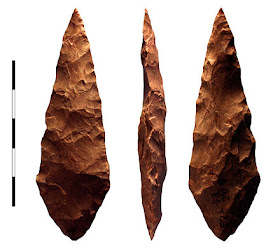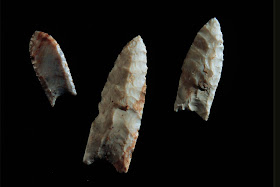Everyone needs something that gets them excited! I love primitive skills...welcome to my journey.
Thursday, May 2, 2019
Saturday, April 6, 2019
Thursday, April 4, 2019
Handhaxe & Chopper
The snow has melted, the floods have receded, I can find my rock pile. Feeling a little rusty, I did manage knap out a grainy handaxe and a couple of choppers. I am a fan of the field expedient chopper, a couple of minutes with a hammer stone and you have a capable tool.
Wednesday, March 20, 2019
Open Air Neanderthal Workshop
Earlier this month the public information service, Science in Poland, published an article on the first open air Neanderthal tool making workshop, discovered on the river bank near the village of Pietraszyno, in Southern Poland. The site was dated at 60,000 years old, and showed signs of organized flint working by a community over a long period of time. It was unique in that it was the first Neanderthal workshop not found in a cave. Over 17,000 recovered flint flakes revealed the manufacturing handaxes or knives that were taken away and used elsewhere. Archaeologists were able to reconstruct, from the abandoned debris, the process of manufacturing. Also recovered at the site were bones of rhinoceros, mammoth, and horses. You can find the article at: http://scienceinpoland.pap.pl/en/news/news%2C33186%2Carchaeologists-discovered-flintstone-workshop-neanderthals-southern-poland-it .
Thursday, February 28, 2019
Quartzite Stone Artifacts
A paper was pulished in Scientific Reports, February 2018, on the archaeological site of Porto Maior, above the Mino River basin in northwest Spain. 3,698 stone artifacts were found, in situ, dating from around 200,000 to 300,000 years old. Distinctive were the large cutting tools - handaxes, cleavers, trihedral picks and choppers, almost exclusively of quartzite. Lab analysis showed they were used on site, on wood and bone, probably to break up carcasses, and abandoned. The unique aspect of the assemblage is that it is the first European site discovered, of large cutting tools, that were more relevant in size and weight to assemblages found in Africa and the Near East, than the smaller Acheulean tools of Europe. Archaeologists speculate that there were multiple human lineages living in southwest Europe, with alternative stone tool technologies, around the same period. You can find the story and a link to the Scientific Reports article at:
https://phys.org/news/2018-02-giant-handaxes-groups-early-humans.html
Thursday, February 21, 2019
Blomboc Cave Bone Awls
Some of the earliest speculated evidence of clothing being made comes from the Blombos Cave bone awls, dated at 77,000 years old. In 1991, on the southern tip of Africa, archaeologists discovered bones awls, among other stone artifacts. The bone awls were generally around 5-inches long and made from small antelope limb bones. The bones may have been broken in the process of extracting marrow, or deliberately broken to make a tool. They show signs of a stone flake being used to sharpen the bone shards to a point. The manufacture of these awls illustrate advanced thinking. Interestingly, studies of the polished areas of the awls, show they were used held between the thumb and forefinger, of the right hand, 3/4 inches from the tip. Bones awls were used to shred plants for fibers, punch holes in wood or hide, or punch lacing holes for making clothing.
Saturday, February 9, 2019
Chopping Tools
At some point you need something to CHOP with, to fell shelter poles, butcher a mammoth, reduce excess material in the process of making a bow or hollowing a canoe. Hand held tools include the expedient chunk of rock with a angular edge, to removing a few flakes from a quartzite cobble to make a chopper, to the intricate knapping of a multi-purpose hand axe. Chopping can also be facilitated by using antler or stone wedges with a baton. Putting a handle on a sharp edge gives you greater mechanical efficiency. Pictured are various flaked, pecked and ground stone, and antler adze and axes. (Middle picture, antler axe - Tarjus Gaaren)
Thursday, February 7, 2019
Deer Leg Tool Kit
This is my DEER LEG TOOL KIT I use to show possible resources and tools from a white tail deer lower leg, something a hunter today would discard, but earlier peoples would harvest. Left to right: the white tail deer leg. The thin hide is skinned from the leg and scraped, and a possible knife sheath is made from the rawhide (not pictured). The harvested leg bone is shaped into a hide scraper, or shards are abraded into awls or needles, the inner marrow eaten. The dried leg tendon is gently beaten with a wooden baton, or rock, to break and separate the sinew from the tendon sheath. Sinew is used as sewing thread or used to wrap stone points to shafts. The four phalange bones (lower right) can be used as beads, or scored with a stone burin and split. These halves are hollowed with a stone drill and scraped with flakes in the process of making fish hooks. Pointed bones inside the hooves are ground down into arrowheads. Any hide scraps or hooves are slowly boiled, in a clay pot, leaching out the collagen. This brownish liquid is reduced down - making hide glue. The remaining item is a deer toe rattle made out of the deer leg bone, deer hide, hooves, some fur, and hide glue. These tools demonstrate the resourcefulness of early man and just some of the possible uses of just the lower leg of an animal.
Tuesday, February 5, 2019
The Short-Faced Bear
The SHORT-FACED BEAR is an extinct giant species that inhabited Nebraska until around 11,000 years ago. It was the most common early North American bear, and most abundant in California. Around Lubbock Lake, in Texas, is the only evidence ever found, of humans butchering a short-faced bear. There are two recognized species: Arctodus pristinus and Arctodus simus, with the latter considered to be one of the largest known terrestrial mammalian carnivores that has ever existed. The average short-faced bear stood 8–10 feet tall on its hind legs, while a large specimen would have been 11–12 feet tall, with a 14-foot vertical arm reach. When walking on all fours, it stood 6 feet high at the shoulder, tall enough to look a man in the eye. It is estimated to have weighed in excess of 2,000 lb.s. At Riverbluff Cave, in Greene County, Missouri, a series of claw marks 15 feet high have been found along the cave wall. A. simus was suggested to have been highly carnivorous and as an adult would have required about 35 lb.s of flesh per day to survive.
Heat Treating
Stone was used by early man to make durable, sharp tools to cut, scrape, chop, pierce, pound, and bore. These tools demonstrated his cognitive ability to plan, reason, and communicate skills. There is evidence that on the southern tip of Africa, at Pinnacle Point, early man used fire to alter stone - a technic known as HEAT TREATING. This treatment altered the poor quality properties of silcrete - making it glossier, easier to shape and flake, sharper. Silcrete is a conglomerate formed when surface sand and gravel are cemented by dissolved silica, resembling quartzite. The picture below shows an unheated piece of silcrete, next to a heat treated flaked tool. The artifacts collected date back 72,000 years and shows fire being commanded in a sophisticated manner. Before this discovery, heat treating was thought to have originated in Europe around 25,000 years ago. Researchers replicated the heat treating process by burying spalls of silcrete beneath a fire pit. The resulting process changed the properties of the mineral turning it reddish in color, glossier, and easier to flake. Heat treating is used today by modern flintknappers to alter difficult stone, using kilns and ovens to control the level of heat and duration.
Friday, February 1, 2019
Atlatl Dart Foreshafts
I thought this insight was of value. A number of years ago, Bob Berg, of Thunderbird Atlatl, and Atlatl Bob/William Perkins, agreed on a point (which they rarely do) - foreshafts in atlatl darts are ineffective for big game hunting. There are scores of atlatl foreshafts that have been discovered, along with a few dart shafts without foreshafts, from prehistoric times. I know I have seen numerous books with line drawings always depicting darts with foreshafts. Mr. Berg and Mr. Perkins contend - that thru numerous experiments, hunting experiences, and others hunting experiences, that these fore shafts have limitations. A dart, with a foreshaft, will penetrate as deep as the foreshaft. If the foreshaft is 5-inches, it will penetrate 5-inches, sometimes with the foreshaft breaking at the connection. Darts without, will penetrate deeper and be more effective in taking big game. Their conjecture is that darts with foreshafts were more for warfare than hunting.
Thursday, January 31, 2019
Evidence of Atlatl in N.A.
Paleo Indians, in North America, used darts and atlatls to hunt big game such as mammoths and giant ground sloths. Most of us naturally assume this, but archaeologists studying microscopic fractures on Paleo-Age stone points have been able to determine clues for “high velocity, mechanically propelled impacts.” It is largely thought that early inhabitants did not have the bow & arrow, so atlatls were used to hurl long, stone tipped darts for hunting. Also, some evidence of atlatl use come from finding banner stones - weights attached to the atlatl to increase its effectiveness by giving mass and balance to the weapon system. Studying hundreds of Paleo Indian era points, researchers calculated fracture velocities related to spear thrusts, as opposed to a thrown javelin, or atlatl or bow strike. Different velocities create distinct telltale fractures. The study cited atlatl & dart use around 11,000 years ago in North America. In the Old World it was calculated atlatl use began about 20,000 years ago. The value of the research is helpful to show when these technologies emerged and how they traveled across the continent.
Wednesday, January 30, 2019
Pressure Flaking
In April of 2017 a paper was published from the excavations in Sibudu Cave, in KwaZulu-Natal, a province of South Africa. 25 stone points were unearthed with the telltale signs of an emerging new technology for working stone...pressure flaking. Evidence pointed to the use of a sharpened bone to push against the edge of a stone blank to remove small flakes...sharpening, thinning, and shaping stone points. This technic allowed more control over the finished tool. These artifacts were dated at around 77,000 years old. In Europe, pressure flaking on stone tools was documented about 20,000 - 25,000 years old. There was evidence that a number of these tools had been hafted on a spear or dart from the glue residue. Fourteen of the 25 points had impact fractures and wear indicating they were used for hunting. Because of the excellent conditions of the cave in preserving these artifacts, animal residue, blood and bone fragments, plant fibers and residue were also identified.
Tuesday, January 29, 2019
Maheffy Cache
MAHEFFY CACHE: In 2008 a landscaping crew, on the property of a Boulder, Colorado, resident uncovered a collection of stone tools in a hole the size of a shoe box. Archaeologists confirmed this was a Clovis-Age cache, dated around 13,000 years old, consisting of over 80 stone implements. It consisted of an assortment of platters, bifacial knives, small blades, flakes, and one resembling a double bitted axe. The key to dating the assemblage was protein residues discovered on several of the tools that were used to butcher extinct camels and horses, bear, and sheep. The stone was quarried, and carried in, from sites in Utah, Wyoming, and Colorado. This cache is significant because there have been so few recovered and studied, in such pristine condition.
Fire Piston
Tuesday, January 22, 2019
Backed knives
BACKED KNIVES are a distinctive tool form from the Paleolithic. The flakes chosen can be broad and heavy, with cortex still attached on the supporting edge, or thin and long. The distinguishing factors are - one edge is sharp and untouched, with the opposite edge dulled. The dulled edge allows finger support and pressure for cutting activities. It has not been clearly established if this blade was meant to be hafted, or hand held. Backed knives served as cutting edges to use on wood, plant material, or animal products. Pictured also are several Neanderthal backed knives.
Monday, January 21, 2019
Hafting
Dana Kern made a comment on a previous post on the Schoningen spears, a set of six wooden pointed javelins, dating back to over 300,000 years ago, asking why there were no stone tips? The archaeological record shows numerous stone spear points after the 300,000 year mark. In fact, researchers excavating the Kathu Pan site in Southern Africa have found a spearpoint potentially dated to around 500,000 years ago. They ascertain it is a spearpoint by studying the tip fracture to other known spearpoints. Of course, continuing study is going into this. Early man recognized the greater effectiveness of sharp stone spear tips in taking game. But, the whole process of hafting, attaching a point to a shaft, is a complicated subject. Fore thought and planning have to proceed making a spear. The use and ability to control fire is necessary to produce an adhesive filler if used. Making a suitable notch and binding it with plant cordage or animal hide or sinew, is key to producing a sufficiently strong haft, that will hold when facing potentially dangerous or cornered game. Scientists also recognize the importance that language plays to communicate the ideas and methods to make spears and coordinate hunts. Of course, you can’t forget the skill to produce a stone point is paramount. This doesn’t answer why the Schoningen spears did not have stone tips. But, but hopefully we can recognize what a technical achievement the act of fastening a stone to a wooden shaft is.

















































